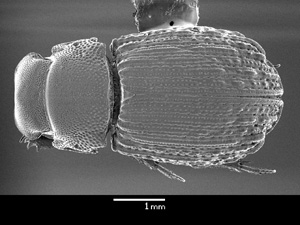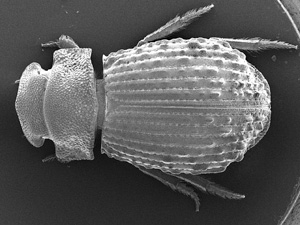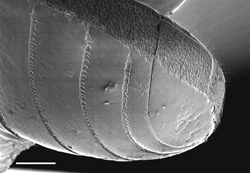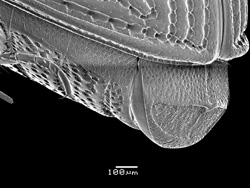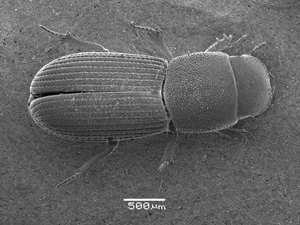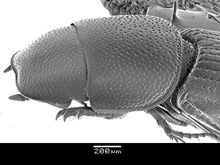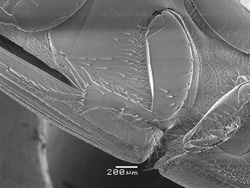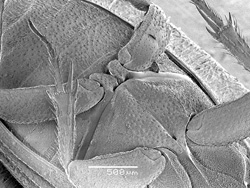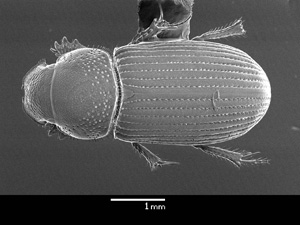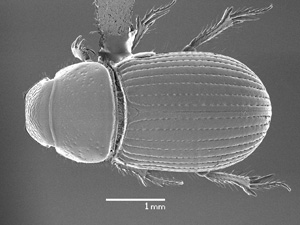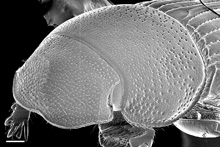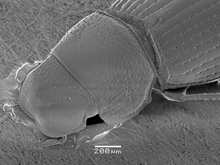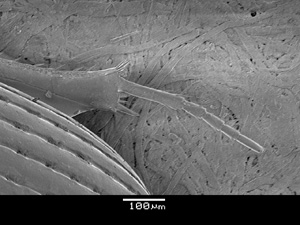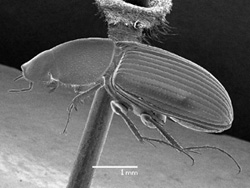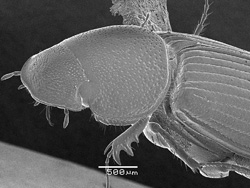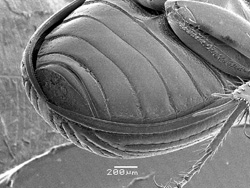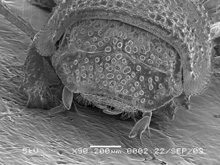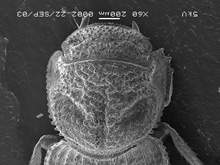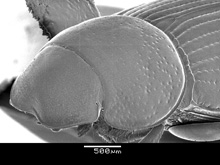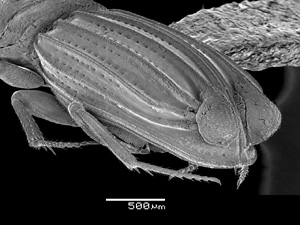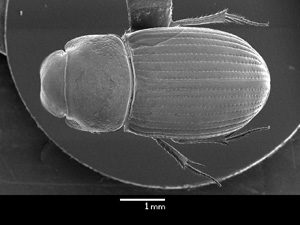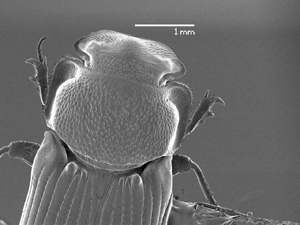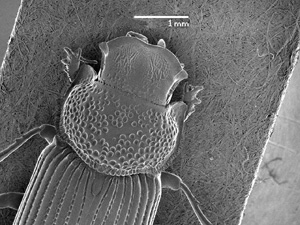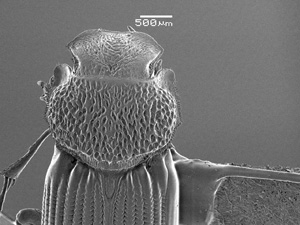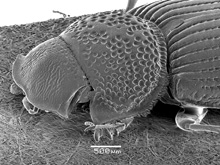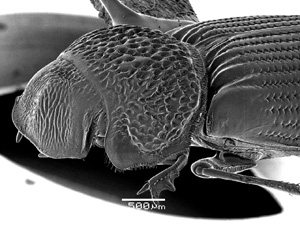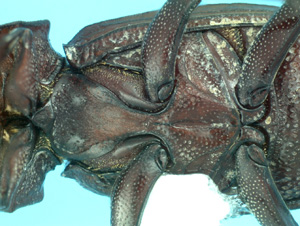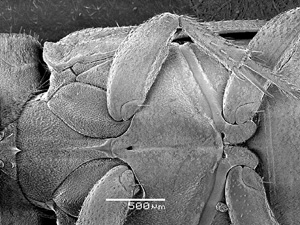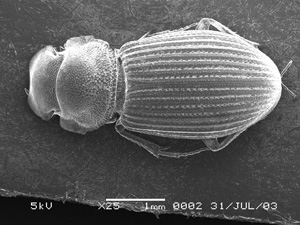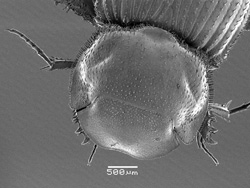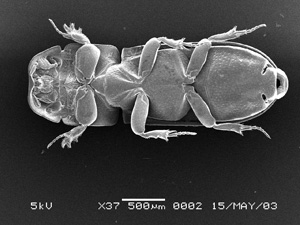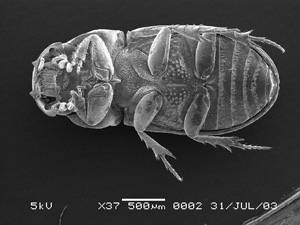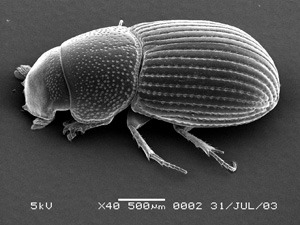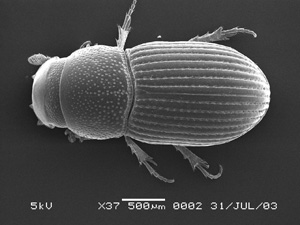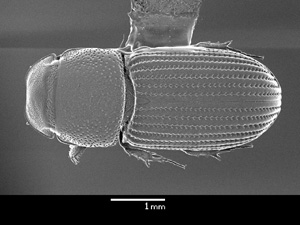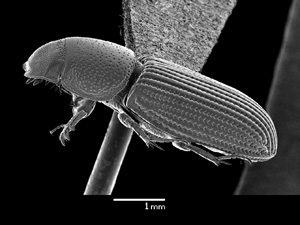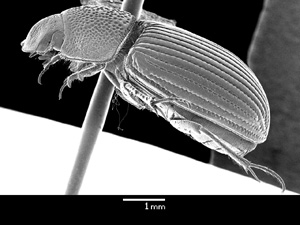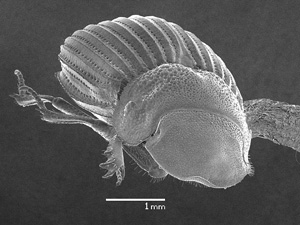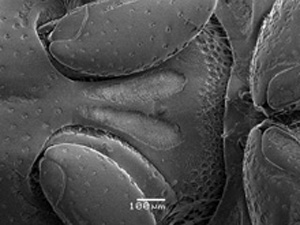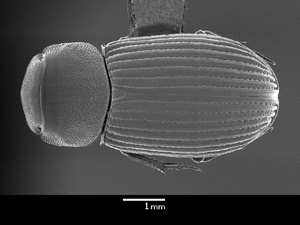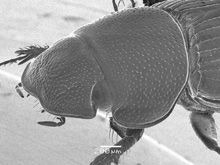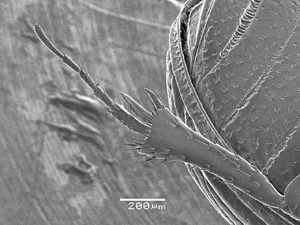|
| Not included in the key is Nettelia Islas (N. euparinoides Islas from Mexico), whose description lacked needed details, and no specimen was available for study |
1.
. |
Head with mandibles exposed (Fig. 1). Pronotum with distinct T-shaped grooves (Fig. 2) |
Annegialia
Howden |
| |
1'.
.
|
Head with mandibles hidden beneath clypeus (Fig. 3). Pronotum lacking distinct grooves |
|
|
|
|
Figure 1. Annegialia ataeniformis. |
Figure 2. Annegialia ataeniformis. |
|
|
|
Figure 3. Ataenius opatroides.
|
|
| |
| |
| |
| |
| |
| |
| |
| |
| |
| |
| |
| |
| |
| |
| |
| |
| |
| |
| |
| |
| |
| |
| |
| |
| |
|
| |
| 2(1). |
Each elytral apex with bulbous process (Fig. 4) |
Cartwrightia Islas |
| |
2'.
|
Elytron lacking bulbous apical process (Fig. 5) |
|
|
|
|
Figure 4. Cartwrightia cartwrighti. |
Figure 5. Ataenius opatroides. |
|
| |
| |
| |
| |
| |
| |
| |
| |
| |
| |
| |
| |
| |
| |
| |
| |
| |
| |
| |
| |
| |
| |
| |
| |
| |
|
| |
3(2).
.
.
.
|
Base of elytral with fifth interval from suture prominent and fifth stria deeply grooved (Fig. 6), and/or head and pygidium with longitudinal rugulae (Fig. 7) |
.
.
.
4 |
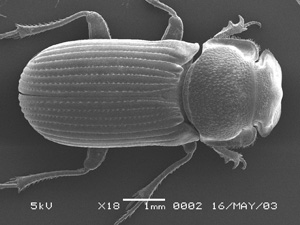 |
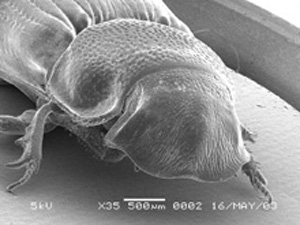 |
Figure 6. Arupaia friedenreichi. |
Figure 7. Arupaia friedenreichi. |
|
3.
.
.
|
Base of elytra lacking deeply grooved 5th stria. Head and pygidium usually lacking longitudinal rugulae, may have transverse wrinkles or elongated punctures |
|
|
| |
| |
| |
| |
| |
| |
| |
| |
| |
| |
| |
| |
| |
| |
| |
| |
| |
| |
| |
| |
| |
| |
| |
| |
| |
|
| |
4(3).
.
. |
Head lacking longitudinal rugulae, with small setiferous tubercles (Fig. 8). Pronotum and elytral striae finely punctate |
Euparia Saint-Fargeau and Serville |
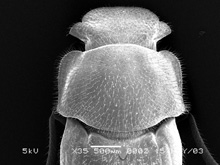 Figure 8. Euparia castanea
Figure 8. Euparia castanea. |
4'.
.
|
Head with longitudinal rugulae. Pronotum coarsely punctate. Elytral striae coarsely punctate or not |
|
|
| |
| |
| |
| |
| |
| |
| |
| |
| |
| |
| |
| |
| |
| |
| |
| |
| |
| |
| |
| |
| |
| |
| |
| |
| |
|
| |
5(4).
. |
Pronotal lateral margin straight, anterior angle rounded and thickened (Fig. 9) |
Arupaia
Stebnicka |
| |
5'.
.
|
Pronotal lateral margin sinuate, anterior angle lobe-like and thin (Fig. 10-11) |
|
|
|
|
Figure 9. Arupaia friedenreich. |
Figure 10. Myrmecaphodius proseni. |
|
|
|
|
Figure 11. Iarupea serratipennis. |
|
| |
| |
| |
| |
| |
| |
| |
| |
| |
| |
| |
| |
| |
| |
| |
| |
| |
| |
| |
| |
| |
| |
| |
| |
| |
|
| |
6(5).
.
. |
Elytra with strial punctures fine, intervals flattened and glossy (Fig. 12). Humeral lobe of elytra comparatively small, projecting more laterally |
.
Myrmecaphodius Martinez |
| |
6'.
.
.
.
|
Elytra with strial punctures coarse, encroaching upon intervals which are raised and dulled (Fig. 13). Humeral lobe of elytra large, prominent, projecting anteriorly |
|
|
|
|
Figure 12. Myrmecaphodius proseni. |
Figure 13. Iarupea serratipennis. |
|
| |
| |
| |
| |
| |
| |
| |
| |
| |
| |
| |
| |
| |
| |
| |
| |
| |
| |
| |
| |
| |
| |
| |
| |
| |
|
| |
7(3).
.
.
. |
Mesocoxae elongate, 3 or more times longer than wide (Fig. 14), touching or narrowly separated from base of elytral epipleura (if separated, distance less than 1/4 width of mesocoxa) |
.
.
.
8 |
| |
7'.
.
.
|
Mesocoxa not greatly elongate, less than 4 times longer than wide (Fig. 15), well separated from base of elytral epipleuron by distinct mesepimeron |
|
|
|
|
Figure 14. Euparixia duncani. |
Figure 15. Ataenius pseudostercorator. |
|
| |
| |
| |
| |
| |
| |
| |
| |
| |
| |
| |
| |
| |
| |
| |
| |
| |
| |
| |
| |
| |
| |
| |
| |
| |
|
| |
8(7).
.
. |
Meso- and metatibia apparently with one apical spur, second spur reduced and held close to large spur. Pronotal base and lateral margin serrate (Fig. 16) |
.
Euparixoides Hinton |
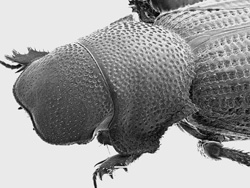 Figure 16. Euparixoides johnsoni
Figure 16. Euparixoides johnsoni. |
8'.
.
|
Meso- and metatibia with 2 distinct apical spurs. Pronotal base and margin not serrate |
|
|
| |
| |
| |
| |
| |
| |
| |
| |
| |
| |
| |
| |
| |
| |
| |
| |
| |
| |
| |
| |
| |
| |
| |
| |
| |
| |
|
| |
9(8).
.
.
.
.
. |
Body elongate with pronotum and elytra narrowed toward base giving a constricted appearance (Fig. 17). Pronotal narrowing causes posterior angle to be indistinct or apparently situated well anterior to normal position. Pronotal lateral margin lacking row of scale-like setae. Elytra not inflexed along interval 8 |
.
.
.
.
Euparixia
Brown |
| |
9'.
.
.
.
.
|
Body elongate oval, not notably constricted in appearance (Fig. 18). Pronotum with distinctive posterior angle and lateral margin usually bearing a row of scale-like setae. Elytra inflexed along interval 8, forming a pseudepipleuron |
|
|
|
|
Figure 17. Euparixia boliviana. |
Figure 18. Lomanoxia melloi. |
|
| |
| |
| |
| |
| |
| |
| |
| |
| |
| |
| |
| |
| |
| |
| |
| |
| |
| |
| |
| |
| |
| |
| |
| |
| |
|
| |
10(7).
.
. |
Meso- and metatibial apex with 3 distinct, spinose processes in addition to the 2 spurs, lacking fringe of spinules (Fig. 19) |
.
.
11 |
| |
10'.
.
.
|
Meso- and metatibial apex with 2 or fewer processes in addition to the 2 spurs, frequently fringed with many small spinules (Fig. 20) |
|
|
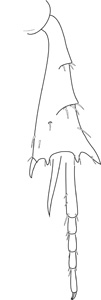 |
 |
| Figure 19. Aphotaenius carolinus, metatibia. |
Figure 20. Ataenius sp., metatibia. |
|
| |
| |
| |
| |
| |
| |
| |
| |
| |
| |
| |
| |
| |
| |
| |
| |
| |
| |
| |
| |
| |
| |
| |
| |
| |
|
| |
11(10).
.
. |
Body strongly flattened. Abdominal sternites with sutures obliterated medially (Fig. 21). Head mildly to strongly granuate |
.
Passaliolla Balthasar |
| |
11'.
.
.
|
Body cylindrical to flattened. Abdominal sternites with sutures complete and visible (Fig. 22). Head rarely with weak granulations |
|
|
|
|
Figure 21. Passaliolla corticalis. |
Figure 22. Aphotaenius carolinus. |
|
| |
| |
| |
| |
| |
| |
| |
| |
| |
| |
| |
| |
| |
| |
| |
| |
| |
| |
| |
| |
| |
| |
| |
| |
| |
|
| |
12(11).
.
. |
Body cylindrical, nearly oval (Fig. 23-24). Clypeus often with angulation or a tooth either side of emargination |
.
Aphotaenius Cartwright |
| |
12'.
.
.
|
Body flattened, parallel-sided (Fig. 25-26). Clypeus rounded either side of emargination
. |
|
|
|
|
Figure 23. Aphotaenius carolinus. |
Figure 24. Aphotaenius carolinus. |
|
|
|
|
Figure 25. Saprosites sulcatus. |
Figure 26. Saprosites sulcatus. |
|
| |
| |
| |
| |
| |
| |
| |
| |
| |
| |
| |
| |
| |
| |
| |
| |
| |
| |
| |
| |
| |
| |
| |
| |
| |
|
| |
13(10).
. |
Pronotum laterally explanate with fringe of distinct setae (Fig.27 ) |
.
14 |
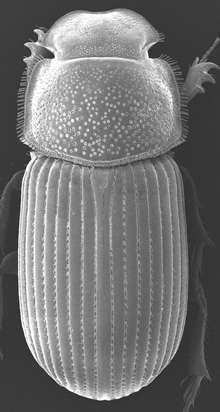 Figure 27. Martineziella dutertrei
Figure 27. Martineziella dutertrei. |
13'.
.
|
Pronotum laterally explanate or not, fringed with setae or not, but not both explanate and fringed |
|
|
| |
| |
| |
| |
| |
| |
| |
| |
| |
| |
| |
| |
| |
| |
| |
| |
| |
| |
| |
| |
| |
| |
| |
| |
| |
|
| |
14(13).
.
. |
Meso- and metatibia long, slender and almost circular in cross section (Fig. 28), lacking setae along majority of length |
.
Selviria
Stebnicka |
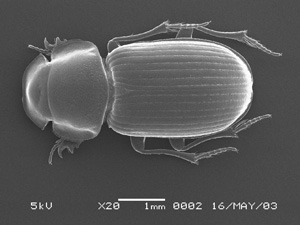 Figure 28. Selvira matogrossoensis
Figure 28. Selvira matogrossoensis. |
14'.
.
.
|
Meso- and metatibia maybe long and slender, but not circular in cross section and with distinct longitudinal rows of setae |
|
|
| |
| |
| |
| |
| |
| |
| |
| |
| |
| |
| |
| |
| |
| |
| |
| |
| |
| |
| |
| |
| |
| |
| |
| |
| |
|
|
| |
15(14).
.
. |
Elytra not inflexed at interval 8 (Fig. 29). Pronotal disc evenly convex
. |
Martineziana Chalumeau and Ozkidmen |
| |
15'.
.
.
|
Body usually inflexed at interval 8 (Fig. 30). Pronotal disc usually unevenly convex, with lateral or basal depressions, or low broad tubercles |
|
|
|
|
Figure 29. Martineziana excavaticollis. |
Figure 30. Lomanoxoides selviriaensis. |
|
| |
| |
| |
| |
| |
| |
| |
| |
| |
| |
| |
| |
| |
| |
| |
| |
| |
| |
| |
| |
| |
| |
| |
| |
| |
|
| |
16(13).
. |
Elytra distinctly inflexed at interval 9, forming a pseudepipleuron (Fig. 31) |
Flechtmanniella Stebnicka |
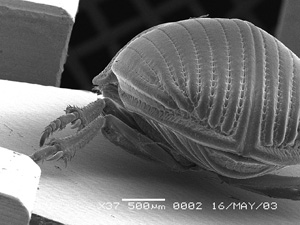
Figure 31. Fletchmaniella laticollis. |
16'.
|
Elytra not inflexed at interval 9 |
|
|
| |
| |
| |
| |
| |
| |
| |
| |
| |
| |
| |
| |
| |
| |
| |
| |
| |
| |
| |
| |
| |
| |
| |
| |
| |
|
| |
17(16).
.
.
.
.
.
.
. |
Meso- and metatarsomere 1 both distinctly longer than long tibial spur (more than 1/4 longer than spur) (Fig. 32); frequently with dense setae on ventral surface (Fig. 33). Meso- and metatarsus usually shorter than tibia. Mesosternum often with 0, 1 or 2 large fossa (Fig. 34). Pronotum shortened, often explanate, always lacking fringe of setae (Fig. 35). Head broad |
.
.
.
.
.
.
.
18 |
| |
17'.
.
.
.
..
.
.
|
Meso- OR metatarsomere 1 same length or shorter than long tibial spur [rare exceptions]; both lacking dense setae on ventral surface. Mesosternum never with large fossa. Meso- and metatarsus usually as long or longer than tibia. Pronotum usually not shortened, not explanate, frequently with lateral fringe of setae. Head variable |
|
|
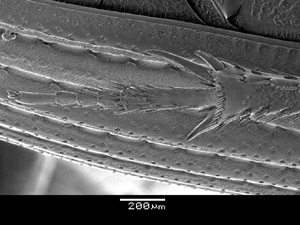 |
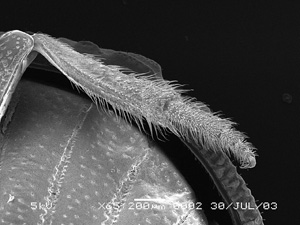 |
Figure 32. Auperia denominata. |
Figure 33. Batesianna tuberculata. |
|
|
|
|
Figure 34. Auperia viejoae. |
Figure 35. Auperia denominata. |
|
| |
| |
| |
| |
| |
| |
| |
| |
| |
| |
| |
| |
| |
| |
| |
| |
| |
| |
| |
| |
| |
| |
| |
| |
| |
|
| |
| 18(17). |
Elytral intervals no where tuberculate |
Auperia Chevrolat |
| |
18'.
|
Elytral intervals tuberculate near apex |
|
|
| |
| |
| |
| |
| |
| |
| |
| |
| |
| |
| |
| |
| |
| |
| |
| |
| |
| |
| |
| |
| |
| |
| |
| |
| |
|
|
| |
19(18).
. |
Pronotum not explanate laterally (Fig. 36). Mesosternum with 2 pit-like fossae |
Napoa
Stebnicka |
| |
19'.
.
|
Pronotum broadly explanate (Fig. 37). Mesosternum lacking fossae |
|
|
|
|
Figure 36. Napoa peckorum. |
Figure 37. Batesianna tuberculata. |
|
| |
| |
| |
| |
| |
| |
| |
| |
| |
| |
| |
| |
| |
| |
| |
| |
| |
| |
| |
| |
| |
| |
| |
| |
| |
|
| |
20(17).
.
. |
Pygidium with apical half glossy, lacking eroded or densely punctured surface (Fig. 38). Body distinctly elongate and parallel-sided |
.
. 21
|
| |
20'.
.
.
|
Pygidium with apical half eroded or distinctly punctured (Fig. 39). Body not exceptionally elongate and parallel-sided, nitidous or not |
|
|
|
|
Figure 38. Ataeniopsis haroldi. |
Figure 39. Ataenius platensis. |
|
| |
| |
| |
| |
| |
| |
| |
| |
| |
| |
| |
| |
| |
| |
| |
| |
| |
| |
| |
| |
| |
| |
| |
| |
| |
|
| |
21(20).
.
. |
Body larger, usually over 3.0 mm, usually black and strongly nitidous. Apical half of pygidium strongly convex and glossy |
.
Ataeniopsis Petrovitz |
| |
21'.
.
.
|
Body small, usually under 3.0 mm, usually reddish-brown and usually dulled. Apical half of pygidium flattened |
|
|
| |
| |
| |
| |
| |
| |
| |
| |
| |
| |
| |
| |
| |
| |
| |
| |
| |
| |
| |
| |
| |
| |
| |
| |
| |
|
| |
| 22(21). |
Head with frontal lobe reduced (Fig. 40) |
Iguazua Stebnicka |
| |
22'.
.
. |
Head with frontal lobe prominent (Fig. 41)
.
. |
|
|
|
|
Figure 40. Iguazua blackwelderi. |
Figure 41. Saprosites peregrinus. |
|
| |
| |
| |
| |
| |
| |
| |
| |
| |
| |
| |
| |
| |
| |
| |
| |
| |
| |
| |
| |
| |
| |
| |
| |
| |
|
| |
23(20).
.
.
. |
Mesotibia rapidly dilating at apex, apical width equal 1/3 or more of tibial length (Fig. 42). Mesotarsomere 1 shorter than long tibial spur. Metafemur as nearly as large as profemur |
.
.
.
24 |
| |
23'.
.
.
.
|
Mesotibia gradually dilating to apex, apical width less than 1/3 tibia length (Fig. 43). Mesotarsomere 1 same length or longer than long tibial spur. Metafemur smaller (narrower) than profemur |
|
|
|
|
Figure 42. Parataenius derbesis. |
Figure 43. Ataenius pseudostercorator. |
|
| |
| |
| |
| |
| |
| |
| |
| |
| |
| |
| |
| |
| |
| |
| |
| |
| |
| |
| |
| |
| |
| |
| |
| |
| |
|
| |
24(23).
.
. |
Body elongate. Head with transverse wrinkles strongly developed (Fig. 44), surface often granulate or nearly so. Widespread |
.
Parataenius Balthasar |
| |
24'.
.
.
|
Body robust, psammodiiform. Head with or without transverse wrinkles (Fig. 45), surface not at all granulate. Mexico, Panama |
|
|
|
|
Figure 44. Parataenius simulator. |
Figure 45. Haroldiataenius mariarum. |
|
| |
| |
| |
| |
| |
| |
| |
| |
| |
| |
| |
| |
| |
| |
| |
| |
| |
| |
| |
| |
| |
| |
| |
| |
| |
|
| |
25(23).
.
.
.
. |
Body stout, ovoid, resembling Aphodius (Fig. 46); most with reddish elytra. Mesotibia with greatly reduced lateral spine on outer apical angle (rare exceptions). Head never with transverse wrinkles. Panama and South America |
.
.
.
.
26 |
| |
25'.
.
.
.
.
|
Body form variable, usually elongate, parallel-sided, slightly flattened; rarely with reddish elytra. Mesotibia with or without lateral spine on apical angle (Fig. 47). Head often with transverse wrinkles (Fig. 48). Widespread |
|
|
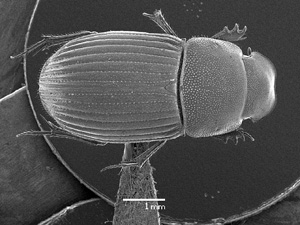 |
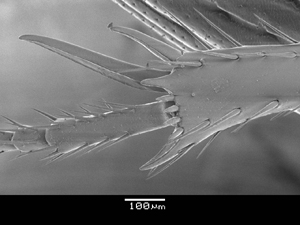
|
Image 46. Lomanoxoides nigrolineatus. |
Image 47. Ataenius picinus. |
|
|
|
Image 48. Ataenius picinus. |
|
| |
| |
| |
| |
| |
| |
| |
| |
| |
| |
| |
| |
| |
| |
| |
| |
| |
| |
| |
| |
| |
| |
| |
| |
| |
|
| |
26(25).
.
|
Clypeus with clypeal teeth (Fig. 49)
. |
Bruchaphodius
Martínez |
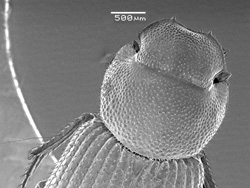 Image 49. Bruchaphodius ovalipennis
Image 49. Bruchaphodius ovalipennis. |
26'.
|
Clypeus evenly rounded at both side of emargination |
|
|
| |
| |
| |
| |
| |
| |
| |
| |
| |
| |
| |
| |
| |
| |
| |
| |
| |
| |
| |
| |
| |
| |
| |
| |
| |
|
| |
27(26).
.
. |
Pronotal disc unevenly convex, with basal swellings (L. setosus, Fig. 50) OR with distinct mesotibial spine on outer apical angle (L. tesari) |
Lomanoxoides Stebnicka
(in part) |
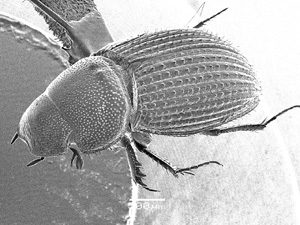 Figure 50. Lomanoxoides setosus
Figure 50. Lomanoxoides setosus. |
27'.
|
Pronotal disc evenly convex. Outer mesotibial apical spine greatly reduced |
|
|
| |
| |
| |
| |
| |
| |
| |
| |
| |
| |
| |
| |
| |
| |
| |
| |
| |
| |
| |
| |
| |
| |
| |
| |
| |
|
| |
28(26).
.
.
.
.
. |
Pronotum distinctly emarginated at posterior angle, emargination bounded by small teeth (Fig. 51); explanate on anterior angles. Metatibia very narrow, metatarsi narrow and elongate (Fig. 52), basal tarsomere distinctly longer than long spur. Body small, length nearly 2.0 mm |
.
.
.
.
Tanyana
Stebnicka |
| |
28'.
.
.
.
|
Lacking above character combination. Pronotal margin rarely modified as above. Tibia and tarsi usually more robust. Body larger, length rarely under 3 mm |
|
|
|
|
Figure 51. Tanyana guayanaensis. |
Figure 52. Tanyana guayanaensis. |
|
| |
|
| |
29(28).
.
. |
Elytra with preapical umbone, intervals setiferous and tectiform, surface microreticulate. Chile
. |
Oxyataenius Dellacasa and Stebnicka |
| |
29'.
.
|
Elytra lacking preapical umbone, intervals variable, surface variable. Wide spread |
|
|
| |
| |
| |
| |
| |
| |
| |
| |
| |
| |
| |
| |
| |
| |
| |
| |
| |
| |
| |
| |
| |
| |
| |
| |
| |
|
| |
30(29).
.
.
.
.
. |
Pronotum sinuate at posterior angle, evenly rounded at sides, lacking fringe of setae (Fig. 53). Male metatarsus notably elongate, as long as tibia, narrowed. Male and female basal metatarsomere weakly curved medio-ventrally at basal third (Fig. 54). South America |
.
.
.
.
Ataenioides Petrovitz |
|
|
Figure 53. Tanyana guayanaensis. |
Figure 54. Tanyana guayanaensis. |
|
30'.
.
.
.
|
Pronotum emarginate or not at posterior angle, sides variably rounded, with or without fringe of setae. Tarsi possibly elongat. Basal metatarsomere not curved. Widespread |
|
|
| |
| |
| |
| |
| |
| |
| |
| |
| |
| |
| |
| |
| |
| |
| |
| |
| |
| |
| |
| |
| |
| |
| |
| |
| |
|
| |
31(30).
.
.
.
.
.
.
. |
Body somewhat flattened (Fig. 55). Head in lateral view weakly arched. Pronotum of male nearly circular in dorsal view. Clypeus evenly rounded either side of a very weak emargination, margin uniformly thin across middle (Fig. 56). Terminal segment of maxillary palpi slender. Mesosternum not carinate. Mesotarsi longer than tibia. Abdominal fluting weak to absent (Fig. 57). Male with elongate, curved protibial spur |
.
.
.
.
.
.
Pseudataenius Brown |
| |
31'.
.
.
.
.
.
.
.
.
|
Body shape variable. Head variable, in lateral view weakly to strongly arched. Pronotum not circular in dorsal view. Clypeus with distinct emargination, toothed or not on either side, margin usually thickened at middle. Terminal segment of maxillary palpi thickened at middle. Mesosternum carinate between coxae. Mesotarsi usually not longer than tibia. Abdominal fluting distinct. Male protibial spur not modified |
|
|
|
|
Figure 55. Pseudataenius socialis. |
Figure 56. Pseudataenius socialis. |
|
|
|
Figure 57. Pseudataenius socialis (male). |
|
| |
| |
| |
| |
| |
